

Fine-Tuning Your
|
|||||
|
Note: this article was discussed with Rick Keller of Great War Militaria and has his blessing. The uniform improvements detailed in this article (if GWM were to do the work) would add substantially to the cost of a basic uniform. |
![]() So, you've bought yourself a German WWI tunic, trousers, and overcoat from GWM. They are, in my opinion, the best quality product of their kind available; but... you can make them just a little better. If you are a perfectionist like me, you may want to make it a little closer to the real thing, and after all, that's what this hobby is all about -- doing it right, being just as authentic as possible, and (dare I say it?) having
fun. Sometimes that last part gets forgotten. The steps described in this article are generally applicable to all German uniforms that have the particular features referred to. These steps are highly recommended.
So, you've bought yourself a German WWI tunic, trousers, and overcoat from GWM. They are, in my opinion, the best quality product of their kind available; but... you can make them just a little better. If you are a perfectionist like me, you may want to make it a little closer to the real thing, and after all, that's what this hobby is all about -- doing it right, being just as authentic as possible, and (dare I say it?) having
fun. Sometimes that last part gets forgotten. The steps described in this article are generally applicable to all German uniforms that have the particular features referred to. These steps are highly recommended.
![]() Unless these buttons have been painted as on the m.1915
or some simplified m.1910 tunics, you will need to do something
about the bright yellow color. [The reason for this is that the modern-cast buttons are too bright and crusty looking. Real buttons are smooth and tarnish readily -- MW] Option #1 is to replace them with original tombak buttons. Option #2 involves chemically subduing the color. Use Birchwood Casey's "Super Blue" gun bluing solution on a cotton ball and wipe down all of the hooks and buttons until they turn black. Use a piece of cardboard with a "V" cut into it for a button board to avoid getting bluing on the cloth. Then rinse off the buttons and buff them with a dish-scrubbing pad or furniture refinishing pad (steel wool will work too, if you don't rub too hard) to bring out the highlights. The effect is very close to that of original buttons.
Unless these buttons have been painted as on the m.1915
or some simplified m.1910 tunics, you will need to do something
about the bright yellow color. [The reason for this is that the modern-cast buttons are too bright and crusty looking. Real buttons are smooth and tarnish readily -- MW] Option #1 is to replace them with original tombak buttons. Option #2 involves chemically subduing the color. Use Birchwood Casey's "Super Blue" gun bluing solution on a cotton ball and wipe down all of the hooks and buttons until they turn black. Use a piece of cardboard with a "V" cut into it for a button board to avoid getting bluing on the cloth. Then rinse off the buttons and buff them with a dish-scrubbing pad or furniture refinishing pad (steel wool will work too, if you don't rub too hard) to bring out the highlights. The effect is very close to that of original buttons.
| [Marsh's method: First you have to remove the yellow casting spooge -- I used a Silly-War button board I swiped from Mark Graf and a fine wire brush like used in gun cleaning. After a good scrubbing, the buttons came away looking like the real thing. Next, I used Birchwood Casey's "Brass Black." I actually removed the buttons from the tunic and dipped them in the solution (I found this worked better than the directions, which called for swabbing). Last, after I had built up a nice dark patina, I took some canvas and rubbed the buttons until they came out looking slightly tarnished. When finished, the buttons have the right look -- not funky yellow and not all shined up like for an inspection by the Kaiser, but instead, about what you'd see on the Frontsoldat. The German regulations called for buttons not to be shined while in the field -- on the other hand, the buttons should not be black, crusty and look 90 years old -- RW] |
![]() Replace all of the plastic cuff, collar tab, overcoat skirt, and inside pocket buttons with either original horn, bakelite, celluloid, or hard rubber buttons in brown or black. Many antique shops have jars of antique buttons for cheap or... you can use modern, period-looking buttons -- I recommend "LaPetite" #325 in size 5/8" from your local fabric store. Sew them on using an "X" pattern stitch, not the modern machine "||" stitch. Trouser buttons, with the general exception of the suspender buttons, were often of horn.
Replace all of the plastic cuff, collar tab, overcoat skirt, and inside pocket buttons with either original horn, bakelite, celluloid, or hard rubber buttons in brown or black. Many antique shops have jars of antique buttons for cheap or... you can use modern, period-looking buttons -- I recommend "LaPetite" #325 in size 5/8" from your local fabric store. Sew them on using an "X" pattern stitch, not the modern machine "||" stitch. Trouser buttons, with the general exception of the suspender buttons, were often of horn.
|
 |
|
|
Short collar hooks: |
Long collar hooks: |
Replace the collar hooks and overcoat front hooks with larger and longer ones. These longer hooks are hard to find, but look more like the originals. The long hooks won't slip out of the loops like the short ones will. Amish dry-goods stores sometimes carry these. Be sure to sew them on using heavy hand-sewing thread in tan or grey.
|
|
4. The reinforcement barThe reinforcement bar was a very common feature on all German uniforms and some fabric equipment. These were used anywhere the garment may be subjected to stress, such as the ends of the pocket slits or cuff slits. They were also used on overcoats to hook the large front flap closed. If you wear the Iron Cross First Class or other awards, you can sew these bars on the uniform to hold the heavy pins so you don't have to put them through the cloth itself. These bars are made by taking a piece of doubled thread and making three or four stitches over the spot to be reinforced. |
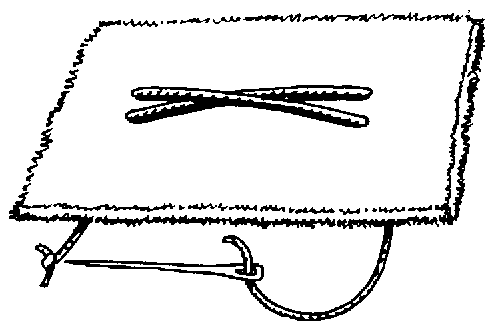 |
|
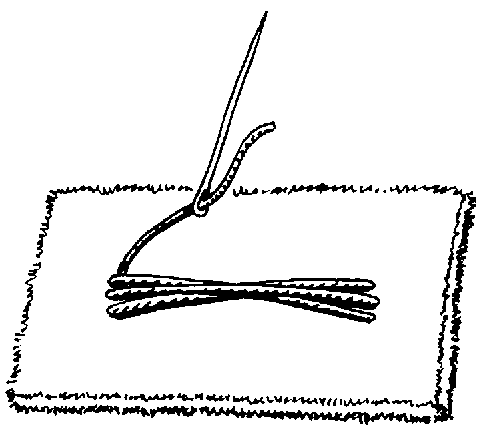
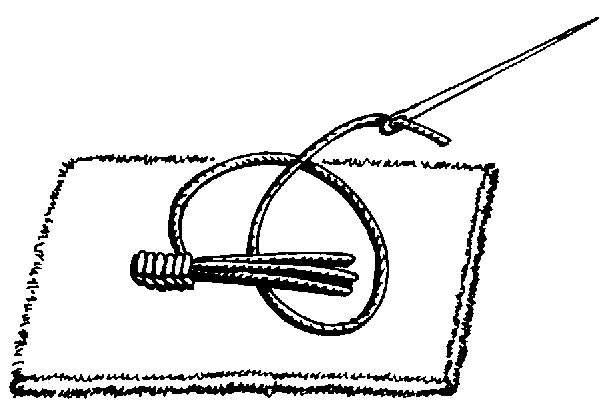
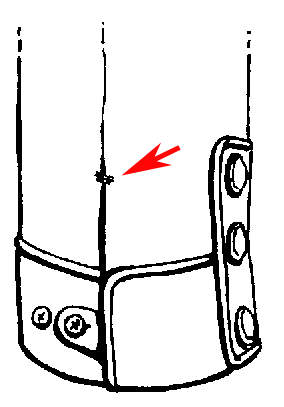
Top of rear cuff adjustment slits;
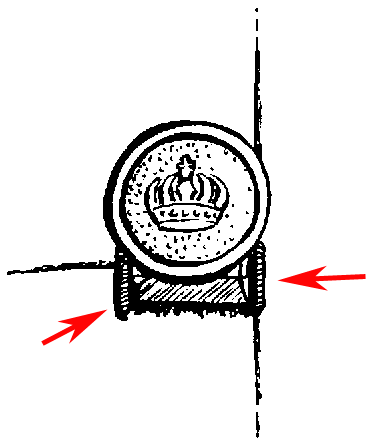

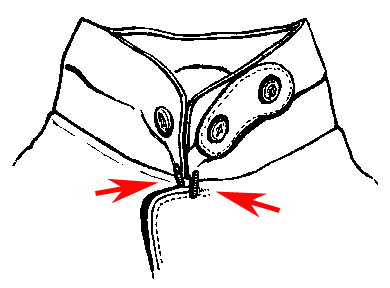
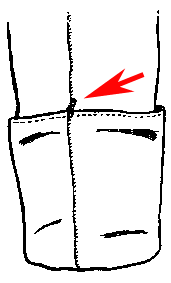
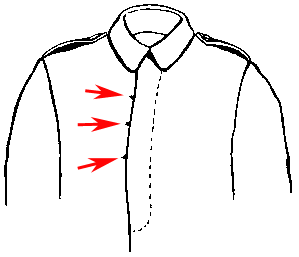
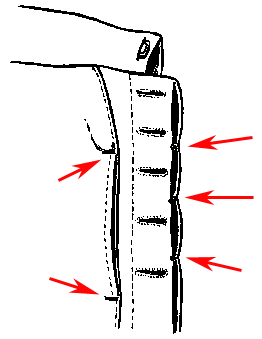
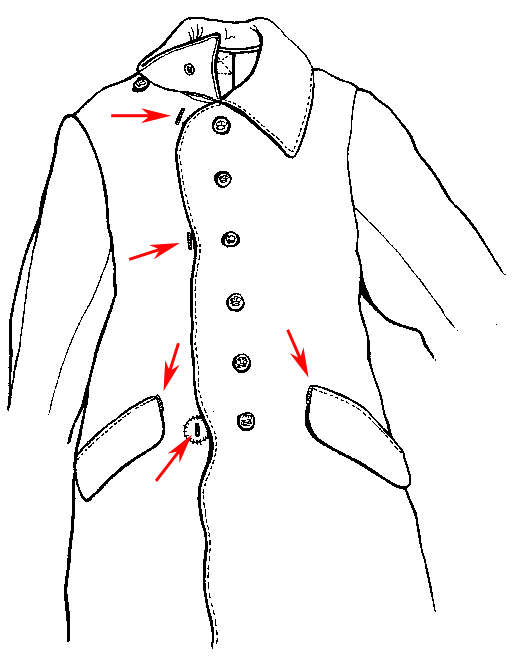
Front and rear of the pocket flaps;
Used as a loop for the top and waist hooks for the coat's closure;
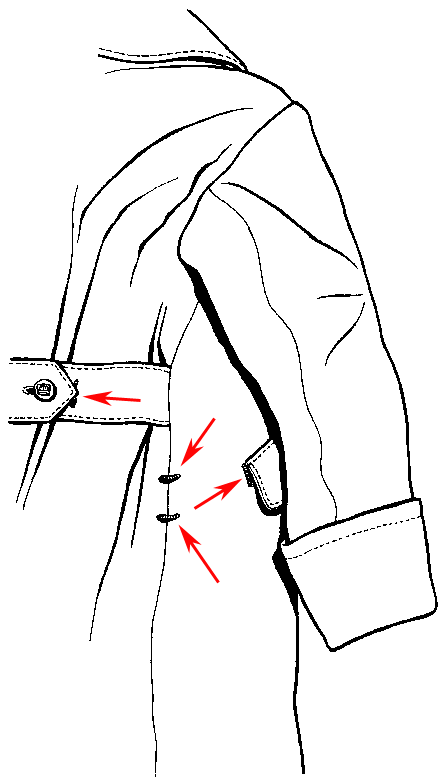
|
|
TrousersUsed on front and back of the pocket slits and at the base of the rear waist split. |
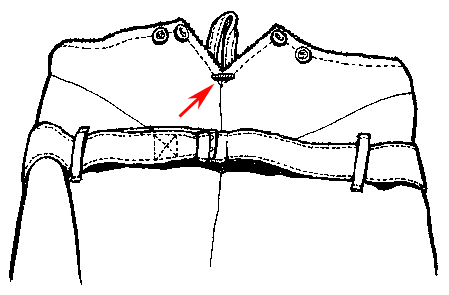 |
|
Most stampings were located on the inner left breast of coats and on the front inside right of trousers. Unless you have access to the proper rubber stamps, these will be difficult to duplicate. Typical stamps include:
B.A. VI 1916 Which stands for: Bekleidungsamt des VI (6th) Armeekorps; indicates Army Corps acceptance, accompanied by a date.
J.R. 23 Which stands for: Infanterie-Regiment 23 (the German printed "I" looks like a "J"); Unit designation, frequently used. [So of course, also J.R. 111, J.R. 63, J.R. 92, etc.]
1.K. Which stands for: 1st. Kompagnie; Often, the company is indicated.
I, II, III, IV Garnitür stamp; Roman numeral indicating issue grade (suitability for various duties) of the item.
I=Field Service
II=Parade
III=Walking-out
IV=Daily duty
B.J.A. If the garment was repaired, it was stamped like this to indicate it had been repaired.
Size stampings for the tunic may be found inside. [This will be covered under the Stamp article] Lastly, the soldier may sew in a laundry label with his name and unit indicated on it [Marsh Wise makes these (Horrors, a crass commerical message here), for info e-mail him at mwise@reenactor.net]. The name may also be written on the lining itself. If this is your choice, please use a period pen or indelible (purple) pencil to mark it with -- no ballpoints!
A final note on stampings; uniforms often included some of the above markings, but not always all of them.
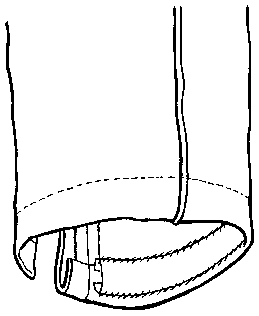
A unique feature on German trousers was a strip of white cotton twill (approx. 2" wide) sewn to the inside of the cuff and tacked in place, thus preventing (I assume) the cuff from filling with dirt and protecting the wool from boot polish. The white twill is easy to replace when it gets too dirty. This feature may have been dropped from late production trousers.
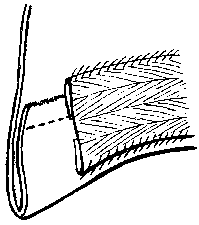
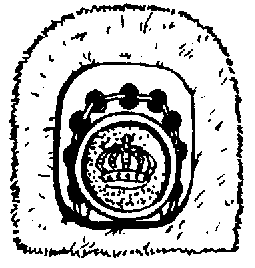
German uniforms utilize four hooks to help support the weight of the belt and its equipment. The two straight side hooks and the two rear "button" hooks are sewn into the tunic itself in order to better distribute the weight. Needless to say, the hooks get a lot of wear and tear, and after a time, they may come loose. If you need to repair these, or if you are "A-R," you may want to replace them in the same manner in which the originals were installed. First, they were sewn to a piece of heavy wool shaped like an upside-down "U." Cut the wool about ½' larger around than the back plate of the hook.
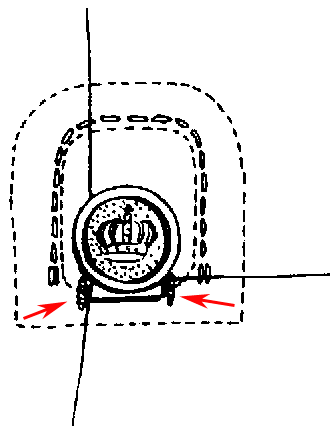
NOTE: The above construction details have been noted through the careful study of items in both my own and in the Great War Militaria Collection (consisting of 40 tunics, 5 overcoats, 8 trousers). The features discussed seem to be common on most of the uniforms studied, but not on all. My thanks go to GWM for generously allowing me access to their collection.